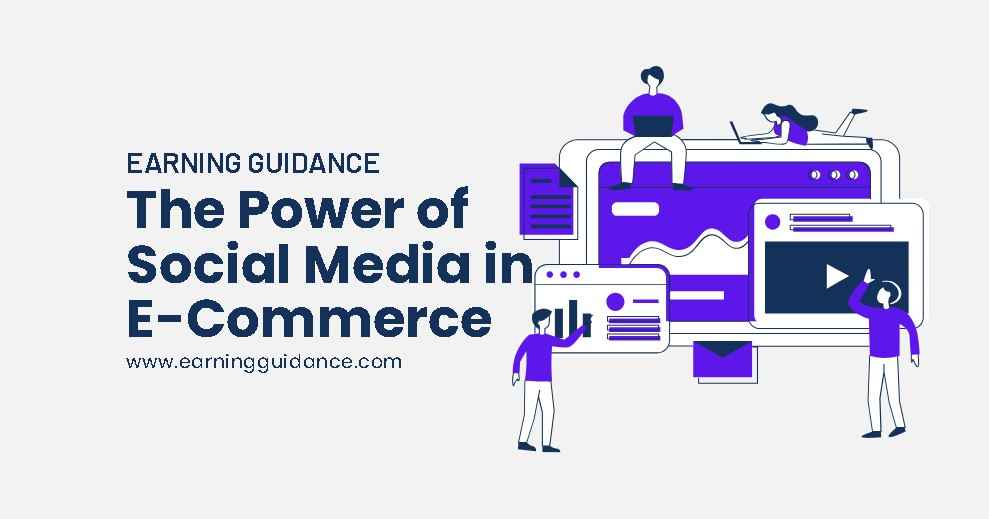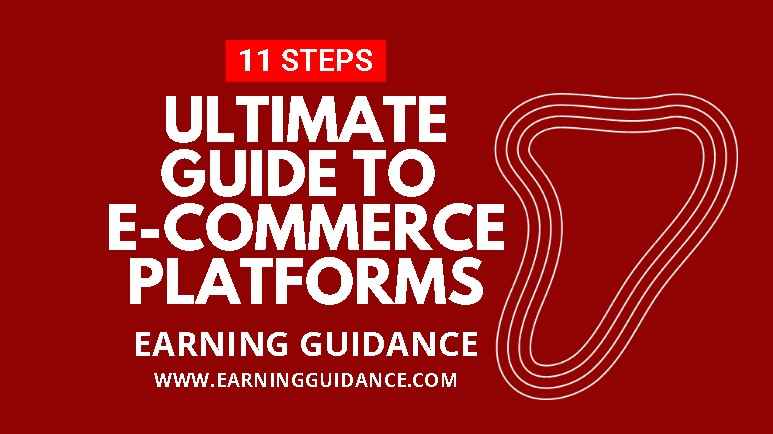Table Of Contents
- 1 1. Introduction
- 2 2. The Role of Social Media in E-Commerce
- 3 3. Social Media Platforms for E-Commerce
- 4 4. Social Media Advertising for E-Commerce
- 5 5. Social Media Influencer Marketing
- 6 6. Social Commerce and Buy Buttons
- 7 7. Customer Engagement and User-Generated
- 8 8. Measuring and Analyzing Social Media Success
- 9 9. Integration of Social Media and E-Commerce Websites
- 10 10. FAQs
- 10.1 A. What is the impact of social media on e-commerce?
- 10.2 B. Which social media platforms are best for e-commerce marketing?
- 10.3 C. How can social media advertising benefit e-commerce businesses?
- 10.4 D. How can I measure the effectiveness of my social media strategies?
- 10.5 E. What are some successful examples of social media in e-commerce?
1. Introduction
While talking about The Power of Social Media in E-Commerce, Social media has revolutionized the way businesses operate, particularly in the realm of e-commerce. Its significance cannot be overstated, as it has become an integral part of online marketing strategies. Social media refers to online platforms and websites that enable users to create and share content, connect with others, and engage in online communities. In the context of e-commerce, social media plays a pivotal role in reaching and influencing consumers, driving sales, and building brand loyalty.
E-Commerce Payment Gateways – Choosing the Right Solution for Your Business
The growing influence of social media on consumer behavior is undeniable. More and more people are using social media platforms for product discovery, recommendations, and online shopping. According to studies, a significant portion of consumers turn to social media for information and inspiration before making purchasing decisions. This shift in consumer behavior highlights the importance of leveraging social media effectively to thrive in the e-commerce landscape. Although this is a comprehensive guide about Power of social media in E-Commerce, but you can get some extra information from the following resources:
- Facebook Business – Discover how to leverage Facebook for e-commerce marketing.
- Instagram for Business – Learn about the business features and strategies on Instagram.
- YouTube Ads – Explore advertising options on YouTube for e-commerce promotion.
2. The Role of Social Media in E-Commerce
Social media serves as a powerful marketing channel for e-commerce businesses, offering numerous opportunities to connect with target audiences and promote products or services. Some key aspects of its role in e-commerce include:
- Building brand awareness and increasing reach: Social media platforms provide an expansive audience base, allowing businesses to reach a wide range of potential customers. By establishing a strong presence and sharing compelling content, e-commerce brands can build brand awareness and expand their reach.
- Driving traffic and generating leads: Social media platforms offer a gateway to direct traffic to e-commerce websites. By strategically incorporating links and call-to-action buttons, businesses can drive interested users to their online stores, increasing the chances of conversion and lead generation.
Creating a Winning E-Commerce Marketing Plan: Step-by-Step Guide
3. Social Media Platforms for E-Commerce
Various social media platforms offer unique advantages for e-commerce marketing. Here are some prominent platforms and their impact on e-commerce:
- Facebook: With its extensive user base and robust advertising options, Facebook is a powerhouse for e-commerce marketing. Businesses can create engaging content, run targeted ads, and utilize Facebook Shops to showcase and sell products directly on the platform.
- Instagram: Known for its visual appeal, Instagram has become a go-to platform for product discovery and sales. Its visually-driven format allows businesses to showcase their offerings through images and videos. Instagram Shopping features enable seamless purchasing experiences for users.
- Twitter: Twitter provides an opportunity for e-commerce businesses to engage with their audience in real-time. It can be used for customer support, promotions, and sharing updates about new products or offers.
- YouTube: As a video-sharing platform, YouTube is ideal for product demonstrations, tutorials, and building a brand’s authority. E-commerce businesses can leverage YouTube ads and collaborate with influencers to reach a broader audience.
- TikTok and Pinterest: Emerging platforms like TikTok and Pinterest offer unique opportunities for e-commerce marketing. TikTok’s short-form videos and Pinterest’s visual discovery features allow businesses to showcase products creatively and capture the attention of their target audience.
4. Social Media Advertising for E-Commerce
Social media advertising is a crucial aspect of e-commerce marketing, allowing businesses to target specific audiences and maximize their reach. Here are some key platforms and strategies for effective social media ad campaigns:
- Targeted advertising options on Facebook and Instagram: Facebook’s powerful ad targeting capabilities enable businesses to reach users based on demographics, interests, and behaviors. Instagram ads, integrated with Facebook’s ad platform, provide a visually compelling way to engage potential customers.
- Using Twitter ads to reach a relevant audience: Twitter offers various advertising options, including promoted tweets, trends, and accounts. E-commerce businesses can leverage these ads to reach a relevant audience, amplify brand messaging, and drive traffic to their websites.
- YouTube advertising and influencer partnerships for e-commerce promotion: YouTube ads, such as TrueView ads, allow businesses to display their products or services before or during videos. Collaborating with popular YouTube influencers can also generate buzz and drive conversions.
- Strategies for effective social media ad campaigns and ROI tracking: A successful social media ad campaign requires careful planning and optimization. It is essential to define clear objectives, create compelling ad content, and continuously monitor and analyze campaign performance. Tracking key metrics, such as click-through rates, conversions, and return on investment (ROI), helps refine strategies and maximize results.
Mastering E-Commerce SEO: Boost Your Store’s Visibility on Search Engines
5. Social Media Influencer Marketing
Influencer marketing has emerged as a powerful strategy in the realm of e-commerce. Leveraging the popularity and influence of social media personalities can significantly impact brand exposure and trust-building. Consider the following aspects of influencer marketing:
- Harnessing the power of influencers to promote e-commerce products: Influencers, with their dedicated follower base, can effectively endorse and promote products. By partnering with relevant influencers, e-commerce businesses can tap into their influence and reach a highly engaged audience.
- Identifying and collaborating with influencers for brand exposure and trust-building: It is crucial to research and identify influencers who align with the brand’s values and target audience. Building genuine relationships with influencers and establishing mutually beneficial collaborations can enhance brand exposure and credibility.
- Guidelines for successful influencer marketing campaigns: When engaging in influencer marketing, businesses should establish clear guidelines and expectations. This includes specifying content requirements, disclosure of sponsored content, and tracking the effectiveness of influencer collaborations.
6. Social Commerce and Buy Buttons
Social commerce refers to the integration of e-commerce functionality directly into social media platforms, streamlining the purchasing process for users. Key aspects of social commerce include:
- Incorporating e-commerce functionality into social media platforms: Platforms like Facebook and Instagram have introduced features such as Facebook Shops and Instagram Checkout, enabling businesses to create a seamless shopping experience within the social media environment.
- Exploring buy buttons and shoppable posts for streamlined purchasing experiences: Buy buttons and shoppable posts allow users to make purchases directly from social media posts without leaving the platform. By reducing friction in the buying journey, businesses can increase conversions and enhance user experiences.
- Case studies highlighting successful social commerce implementations: Various brands have successfully implemented social commerce strategies. These case studies can provide insights and inspiration for businesses looking to optimize their social media presence for e-commerce purposes.
E-Commerce Trends to Watch Out for in 2023
7. Customer Engagement and User-Generated
Engaging with customers on social media platforms is vital for e-commerce success. User-generated content and active customer interactions play a significant role in brand advocacy and customer experiences. Consider the following:
- Encouraging user-generated content to boost brand advocacy and authenticity: User-generated content, such as customer reviews, testimonials, and social media posts featuring products, enhances brand authenticity and trust. Encouraging customers to share their experiences can result in valuable organic promotion.
- Responding to customer inquiries and feedback on social media platforms: Promptly addressing customer inquiries, concerns, and feedback showcases a brand’s commitment to customer satisfaction. It is essential to actively monitor social media platforms and respond in a timely and professional manner.
- Utilizing social listening for market research and improving customer experiences: Social listening involves monitoring social media conversations to gain insights into customer preferences, industry trends, and brand sentiment. This information can guide businesses in improving their products, services, and overall customer experiences.
8. Measuring and Analyzing Social Media Success
Measuring the effectiveness of social media strategies is crucial for optimizing e-commerce efforts. By analyzing key metrics and utilizing relevant tools, businesses can refine their strategies. Consider the following:
- Key metrics and tools for tracking social media performance in e-commerce: Metrics such as engagement rate, reach, conversions, and revenue generated from social media provide valuable insights. Tools like Google Analytics, social media analytics platforms, and native platform insights help track and analyze these metrics.
- Analyzing engagement, conversions, and revenue generated from social media: Evaluating engagement metrics, such as likes, comments, and shares, allows businesses to gauge the impact of their content and campaigns. Tracking conversions and revenue attributed to social media efforts provides a clear understanding of ROI and helps allocate resources effectively.
- Iterating strategies based on data-driven insights: Data-driven insights obtained from social media analytics enable businesses to identify what works and what doesn’t. By iterating and refining strategies based on these insights, e-commerce businesses can continuously improve their social media performance.
9. Integration of Social Media and E-Commerce Websites
Integrating social media elements into e-commerce websites can enhance user experiences and drive conversions. Consider the following aspects:
- Incorporating social media elements for social proof: Displaying social media feeds, reviews, and testimonials on e-commerce websites enhances social proof. This helps build trust and confidence in potential customers, leading to increased conversions.
- Leveraging social logins and social sharing for enhanced user experiences: Allowing users to log in to e-commerce websites using their social media accounts simplifies the registration process. Additionally, incorporating social sharing buttons enables users to easily share products or content, expanding reach and driving traffic.
How to Drive Massive Traffic to Your E-Commerce Store: Proven Strategies
10. FAQs
Social media has a significant impact on e-commerce. It influences consumer behavior, drives product discovery, enhances brand visibility, and provides a platform for targeted marketing and customer engagement.
The best social media platforms for e-commerce marketing depend on the target audience and business objectives. Facebook, Instagram, Twitter, YouTube, TikTok, and Pinterest are some popular platforms businesses can leverage.
Social media advertising enables businesses to reach a targeted audience, increase brand visibility, drive traffic to their websites, and generate leads. It offers precise targeting options, various ad formats, and the ability to track campaign performance.
To measure the effectiveness of social media strategies, track key metrics such as engagement rate, reach, conversions, and revenue generated from social media. Utilize tools like Google Analytics and social media analytics platforms for data analysis.
Successful examples of social media in e-commerce include brands that have effectively utilized platforms like Facebook, Instagram, and YouTube for product promotion, influencer collaborations, and implementing social commerce features.













3 thoughts on “The Power of Social Media in E-Commerce: Best Practices and Case Studies”